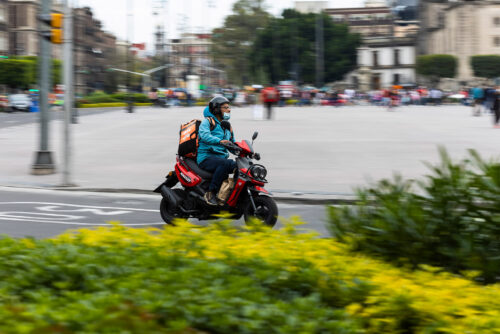
Report | 2024
Decarbonizing Last Mile Delivery: A Courier-Centered Modal Shift Study
What city officials, app-based delivery platforms, community-based organizations, and other stakeholders need to know to electrify and shift on-demand last-mile deliveries.
Descargue el informe en español
Descargue los conceptos claves del informe en español
Improved access to delivery apps and websites, increasing customer demand, and other factors have led to exponential growth in on-demand last-mile deliveries (LMDs). In 2021, McKinsey estimated the on-demand LMD global market value at more than $150 billion.
In cities most affected by smog and particulate matter emissions, it is easy to see how tailpipe emissions from internal combustion engine vehicles (both from driving and idling) contribute to local air quality issues and public health concerns. For this reason, it is a critical time for city officials, app-based delivery platforms, and community-based organizations (CBOs) to take a multi-sector approach toward addressing vehicle emissions and promoting industry-wide shifts to zero-emissions modes.
To help these stakeholders make informed decisions, RMI’s report Decarbonizing Last-Mile Delivery: A Courier-Centered Modal Shift Study provides stakeholders with recommendations and policy solutions they can use to accelerate the electrification and modal shift of on-demand LMDs. The report’s insights come from quantitative modeling and qualitative interviews with couriers, city officials, and CBOs in London, Mexico City, and Seattle.
The report found that successful electrification and modal shift efforts will need to focus on three areas:
Reducing upfront cost
- Local governments will need to provide financial incentives directly to couriers that can be used for transport mode, associated gear, and charging.
- App-based delivery platforms will need to partner with local vendors and dealers to offer couriers discounted prices or leases on low- and zero-emissions transport modes.
Increasing access to charging and battery swapping
- Local governments will need to develop infrastructure plans that incorporate charging (including fast charging) and battery swapping stations placed along convenient delivery routes and high-volume corridors to maintain delivery efficiency and courier earnings.
- Private-sector investment in charging infrastructure through partnerships between app-based delivery platforms and charging infrastructure providers will be critical to create accessible, convenient charging for a variety of modes.
Addressing road safety concerns
- Local governments will need to develop dedicated, protected, and connected lanes and paths for e-bikes and e-motorcycles/mopeds.
- App-based delivery platforms will need to partner with local governments and CBOs to provide safety education for and about couriers.
To accelerate on-demand LMD electrification and modal shift, stakeholders can:
- Support purchase incentives and infrastructure investment;
- Provide equitable and convenient charging and battery swapping sites;
- Encourage public/private collaboration to address barriers to modal shift;
- Promote knowledge and data insights sharing among stakeholders; and
- Use a courier-centric lens when designing incentives, safety programs, and infrastructure
Download the report below. For media inquiries, email media@rmi.org.